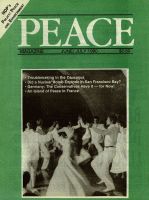
Peace Magazine Jun-Jul 1990, page 4. Some rights reserved.
Search for other articles by PMag staff here
THE two top challenges of the 1990s will be (a) how to preserve the environment from the ravages of militarism, and (b) how to change Europe's security arrangements in view of the end of the Cold War. In this issue of PEACE, several articles deal with certain aspects of these problems.
On the matter of environment-and-mi litarism, we present the very different views of two political parties. The free-wheeling interview (pp.20-23) with the NDP's leader, Audrey Mclaughlin, and its Foreign Affairs critic, Bill Blaikie, shows how carefully they attend to these questions in Parliament. The Canadian Greens, by contrast, can be found in demonstrations-or even in jail- but (so far) not in government. (See p.18.)
Diana Chown (p.12) continues relentlessly to expose the potential hazards of Canada's biochemical facilities at Suffield, Alberta. David McArthur reveals the stealth bomber's darkest secrets; and Dean Babst poses an even more astonishing mystery: Did a nuclear bomb explode accidentally in San Francisco Bay?
Turning to the debate on Security in Europe, we offer two analyses: Simon Rosenblum's musings on the future of the blocs after Germany reunifies, and Hans Sinn's reflections on conservative sweep of the first democratic elections in East Germany. There's also a conversation about the rise of nationalism-especially in the Soviet Transcaucasus.
Next, have a look at Kenneth McNaught's masterly review of Shelagh Grant's history of how Canada became so involved with American military plans in the far North.
But PEACE is not just for the left-brain. This time there's a sensitive tribute to Andrei Sakharov; a portrait of a peaceful commune in France-the Community of the Ark-and a delightful account of a big group meditation in the Kremlin.

Peace Magazine Jun-Jul 1990, page 4. Some rights reserved.
Search for other articles by PMag staff here